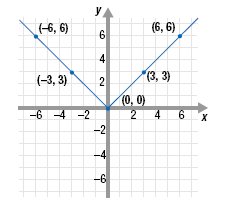Absolute Value Function
The absolute value function is a rule that involves taking the absolute value
of the input variable. Here are some examples:
| f(x) = |x| |
f(x) = |2x| - 5 |
f(x) = |2x - 3| |
Since we can find the absolute value of any real number, the domain of these
absolute value functions is all real numbers. That is, the interval (-∞,
+∞). The range will depend on the individual
function.
To graph an absolute value function, first calculate several ordered pairs.
Then, plot the ordered pairs on a Cartesian coordinate system. Finally, connect
the points with a line.
Example
Make a table of five ordered pairs that satisfy the function f(x) = |x|. Then,
use the table to graph the function.
Solution
To make a table, select 5 values for x. We’ll let x = -6, -3, 0, 3, and 6.
Substitute those values of x into the function and simplify.
|
x
|
f(x) = |x| |
(x, y) |
| -6
-3
0
3
6 |
f(-6)
= |-6| = 6
f(-3) = |-3| = 3
f(3) = |3| = 3
f(0) = |0| = 0
f(6) = |6| = 6 |
(-6, 6)
(-3, 3)
(3, 3)
(0, 0)
(6, 6) |
Now, plot the points and connect them.

Notice the
 shape of the graph. This is characteristic of the absolute
value function, although sometimes the vee is upside down, like this shape of the graph. This is characteristic of the absolute
value function, although sometimes the vee is upside down, like this
 . The point of the vee is called the
vertex. . The point of the vee is called the
vertex.
The domain of f(x) = |x| is all real numbers since we can find the absolute
value of any real number.
To find the range, consider the y-values on the graph. The smallest
y-value is 0. So, the range is y ≥ 0. This is the interval [0,
+∞).
|